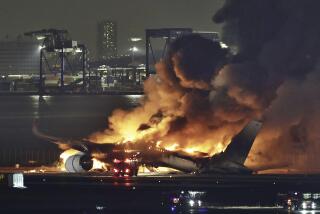Shuttle Inquiry Leans to Leading Edge Theory
- Share via
HOUSTON — Members of the Columbia Accident Investigation Board leaned even further Tuesday toward a theory that the leading edge of the orbiter’s left wing was breached, allowing superheated gases to pass into its interior.
The investigators are inclined to explain that breach by pointing to foam debris that fell from the shuttle booster’s external tank upon liftoff and hit somewhere in the area of the left wing.
When they issue their findings about the Feb. 1 disaster that killed seven astronauts, members of the board said during a briefing, they would have enough evidence to avoid making any guesses.
The investigators said that damage to the shuttle’s leading edge -- rather than to the heat-resistant tiles that cover the surface of the wings -- has taken a more prominent role in the investigation. And, they said, a foam strike on the left wing appears to be a more likely cause of damage than the possibility of a collision with micrometeoroids or space junk.
The shuttle’s leading edge is made of a heat-shielding composite material known as reinforced carbon carbon, which is subject to aging and degradation. If weakened, it could have been vulnerable to a strike by the lightweight foam that was seen falling off the shuttle’s external tank shortly after liftoff.
James Hallock, a board member involved in the engineering and technical analysis of the accident, said the cause “is looking more to be reinforced carbon carbon,” or an adjacent material known as a carrier panel. Nonetheless, Hallock said, he could not completely discount the possibility that a damaged tile allowed heated gases into the wing.
“I haven’t eliminated tiles completely, but it is lower down in my mind,” he said in an interview.
While the analysis of exactly how the leading edge was damaged continues to focus on the foam, Hallock said, the board may never be able to rule out an in-orbit collision with 100% certainty.
Hallock said investigators are trying to determine whether a collision with an object in space would have jarred the shuttle enough to register on sensitive motion instruments known as accelerometers. Investigators have examined about half the relevant data from those accelerometers and have not seen anything that would support such an occurrence.
“If I don’t see any [such] indication, I am going to assign that a very low probability,” Hallock said. “I can’t say it is zero.”
The board also said it has reviewed data from past flights of shuttles that hit micrometeoroids and returned safety to Earth, further leading them away from believing that the orbiter was damaged in space rather than on launch.
Retired Adm. Harold W. Gehman Jr., the board chairman, said the evidence already in hand gives him a lot of confidence that the mystery will be unraveled.
“Accidents with less information than this have been solved before,” he said.
During a lengthy public hearing Tuesday, four NASA engineers provided a highly technical analysis of the thermal forces acting on the shuttle’s left wing as it returned to Earth. The analysis supports the idea that a breach allowed superheated gases to penetrate the wing’s heat shield, probably at the leading edge, and then enter the landing gear compartment. As temperatures rose, wiring from sensors burned up and hot gases under pressure escaped back out to space through the landing gear door.







